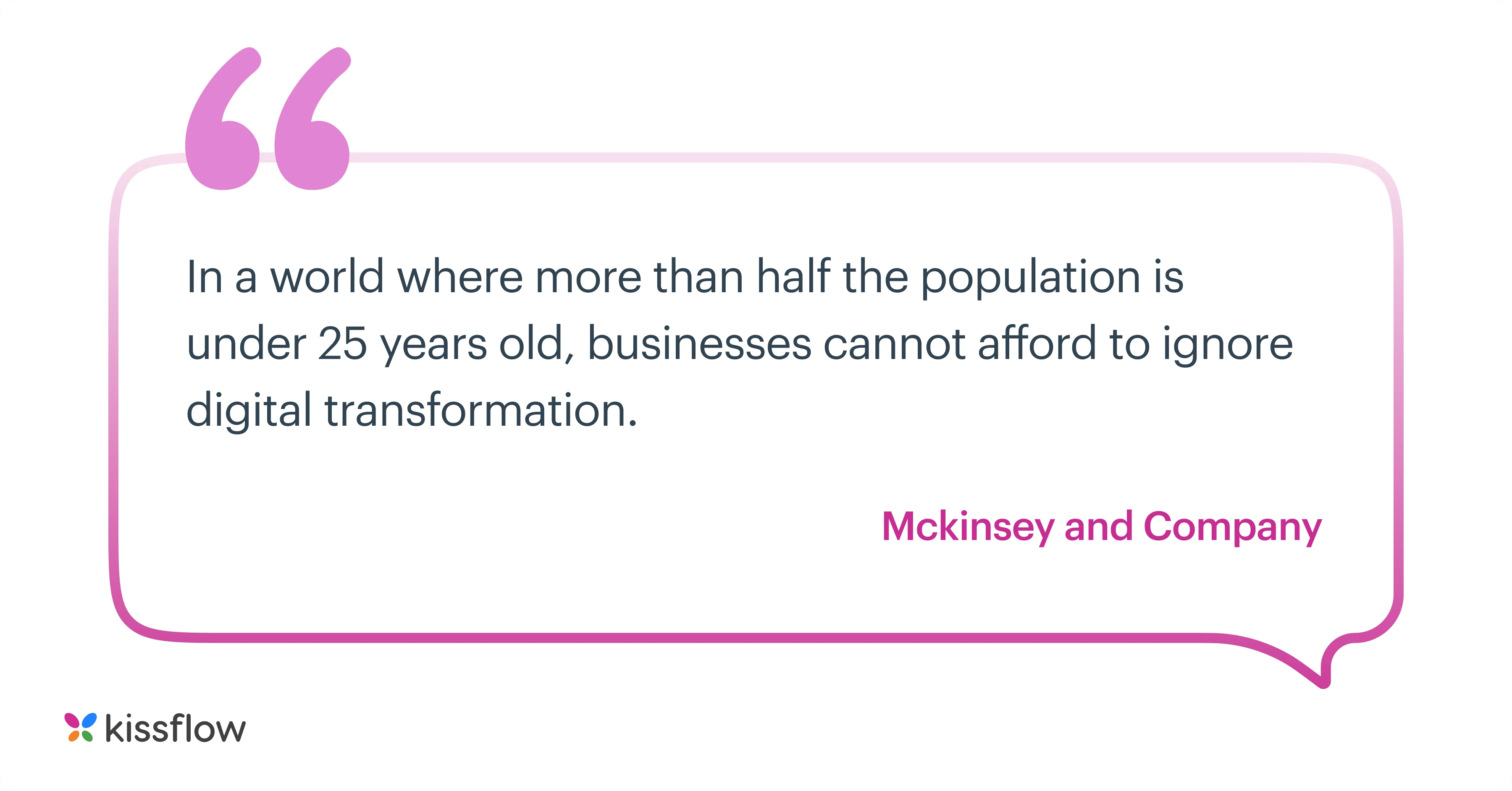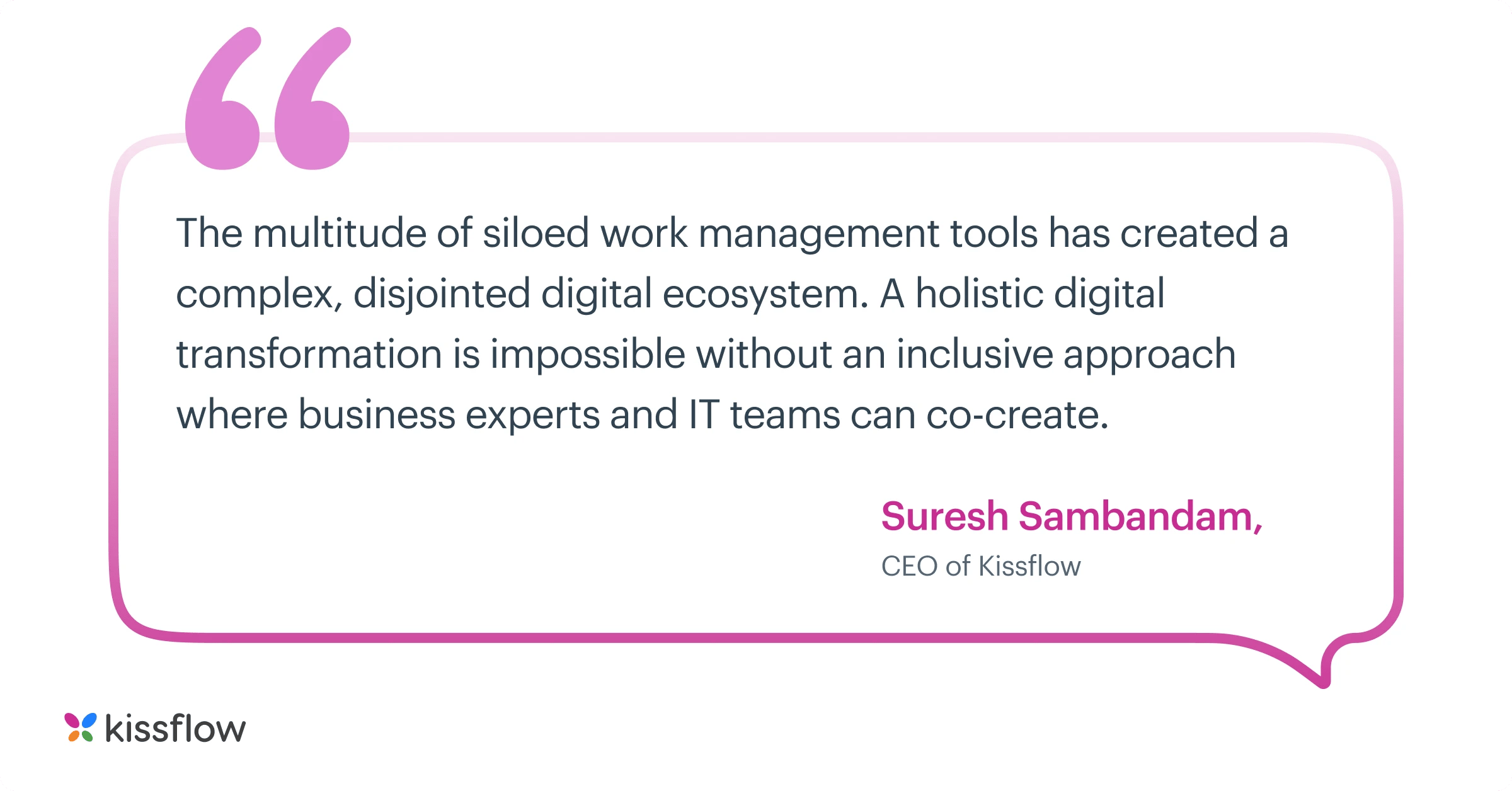What Is Digital Transformation? A Complete Guide
Team Kissflow
Updated on 10 Jun 2025 • 13 min read
What is digital transformation?
Digital transformation refers to integrating digital technologies into every function of a business to enhance how it operates, delivers value, and competes. It’s not only about adopting new tools but also about reshaping business strategies, structures, and customer experiences. This shift enables businesses to optimize operations, respond faster to change, and drive sustained growth.
It could involve anything from moving your data storage to the cloud to implementing automation technologies or using data analytics for informed decision-making.
Enterprise digital transformation refers to the integration of digital technology into all areas of a business, fundamentally altering how the organization operates and delivers value to customers. This transformation involves adopting innovative tools, processes, and strategies to enhance efficiency, drive innovation, and improve customer satisfaction.
Digital transformation for businesses involves integrating digital technologies to streamline operations, enhance customer experiences, and drive innovation. It enables companies to stay competitive, adapt to market changes, and achieve long-term growth.
A digital transformation leader is an individual who authorizes and manages digital change initiatives. This role demands strategic vision, technical knowledge, and strong leadership. Leaders are crucial in navigating the complexities of digital transformation.
Remember, digital transformation isn't just about technology. It's about reshaping businesses to be agile, innovative, and customer-centric.

“Digital transformation is all about unlocking value in your business processes and releasing it back to customers – as well as being agile enough to use data and analytics to create new, innovative experiences.” - David Macdonald | Executive Vice President and Chief Sales Officer, SAS
Think of digital transformation not as a single sprint but as a marathon with multiple laps. It's a journey spanning weeks, months, even years, and it can feel like trying to navigate a labyrinth in the dark. For CIOs and business leaders, grasping the essence of digital transformation, its potential benefits, and its impact is crucial before embarking on this transformative voyage.
Some digital transformation use cases and initiatives
1. Automating processes
Automating manual tasks in an organization can improve efficiency, reduce errors and costs, and free up time for employees to focus on higher-value tasks. It is possible by using technologies like artificial intelligence (AI) and machine learning, workflow automation systems, and robotics.
2. Legacy app modernization
Modernizing legacy applications involves updating or replacing outdated systems with newer, more efficient technologies. This process can help organizations improve the performance and functionality of their applications, as well as reduce the cost and complexity of maintaining legacy systems.
3. Having a modern technology stack
Implementing new technologies that are often designed to be more efficient and easier to use can help streamline processes and reduce the time required to complete tasks. For example, organizations can quickly develop custom applications without needing a large team of developers by investing in technologies that leverage no-code and low-code.

The Power of Low-Code: Transforming App Development for the Better
Thank you for downloading!
4. Improving customer experience
This initiative should provide more personalized and convenient customer experiences or develop new products and services that better meet customer needs. Using chatbots to provide quick and efficient customer service or using virtual reality to allow customers to experience products before they buy them.
5. Reorganizing the organization
This might involve restructuring the organization to better align with digital initiatives or creating new roles and responsibilities to support the digital transformation effort.
6. Enhancing collaboration and communication
Foster collaboration across different departments and teams, enabling them to work together towards a common vision.
7. Expanding into new markets
Digital transformation initiatives might include exploring new business models, entering new markets, reaching new customers, or delivering products and services in new ways.
8. Using powerful data analytics
Using AI, Machine learning, big data, and analytics to make data-driven decisions or to use the Internet of Things (IoT) to collect and analyze data from connected devices.
9. Process transformation
Focuses on refining operations by automating repetitive tasks and enhancing workflow visibility.
Example: Logistics firms digitizing supply chains for real-time tracking.
10. Business model transformation
Creates new revenue streams and delivery models using digital tools.
Example: Netflix’s pivot from DVD rentals to a streaming-first model.
11. Domain transformation
Extends business operations into new markets using digital capabilities.
Example: Amazon launching AWS to move into enterprise cloud services.
12. Cultural and organizational transformation
Promotes agility, cross-team collaboration, and a mindset shift toward continuous innovation.
Example: Banks adopting remote work with secure digital tools to boost productivity.
Examples of Digital Transformation across industries and departments.
| Industry / Department | Example Usecases |
| Manufacturing | Inventory Management, Warehouse Management,
Supplier portal management |
| Banking, Finance, and Insurance | Insurance Claims, Fraud Analysis, Investigation, Loan services |
| Healthcare | Medical care management, Lab Management, Patient lifecycle management |
| Oil & Gas | Approvals processes for property and leasing, Digital e-permit, Environmental approvals |
| HR | Employee Onboarding, Leave Management, Appraisal process |
| Logistics & Supply Chain | Fleet management, Regulatory compliance, Vehicle recall process |
Check out the 9+ Examples of Digital Transformation for every business usecases in detail.But before taking digital initiatives, understand what is possible with digital transformation. It includes recognizing the capabilities of your technology, team, leadership, budget, and customers.

Why does digital transformation matter?
- Companies have recognized the importance of digital transformation and its impact on business. Digitally transformed organizations are expected to contribute to more than half of the GDP by 2023, accounting for $53.3 trillion (IDC, 2020)
- By 2026, global digital transformation spending is expected to hit $3.4 trillion (Statista).
What is digital transformation process?
The digital transformation process is leveraging technology to fundamentally improve business operations, enhance customer experiences, and achieve greater efficiency. It is about integrating new tools, managing workflows, and creating a culture that fosters innovation.
Digital transformation typically progresses through three stages: digitization, where businesses convert manual processes into digital formats; digitalization, which focuses on optimizing existing workflows with technology; and digital transformation, involving a complete overhaul of how a business operates to achieve strategic goals. Key areas include enhancing customer experiences, automating processes, improving data-driven decision-making, and fostering cross-departmental collaboration.
Digital transformation matters more than ever in today's fast-paced, tech-driven world. Here's why
Digital transformation is now the biggest concern for directors, CEOs, and other C-level executives. Based on Statistica [1], by the end of 2026, global digital transformation spending is forecast to reach 3.4 trillion U.S. dollars.
Competitive edge:
Businesses that embrace digital transformation are often more competitive because they can adapt to the changing landscape faster. They can quickly implement new technologies, meet evolving customer expectations, and respond to market changes.
Customer experience:
In the age of instant gratification, customers demand seamless, personalized experiences. Digital transformation allows businesses to leverage data and technology to create these experiences, fostering customer satisfaction and loyalty.
Operational efficiency:
Digital transformation can streamline processes, reduce human error, and increase productivity. For example, automating repetitive tasks can free up employees to focus on strategic, creative tasks that add more value to the company.
Innovation:
Digital transformation fosters a culture of innovation. With access to new technologies and data, businesses can create new products, services, and business models.
Resilience:
The COVID-19 pandemic underscored the importance of digital readiness, which enables business continuity in times of disruption. Companies that had already embarked on their digital transformation journeys were better equipped to navigate the challenges posed by the pandemic.
Companies that have higher digital maturity reported 45 percent [2] higher revenue growth compared to 15 percent for lower maturity companies. According to SAP Center for Business Insights and Oxford Economics, 80 [3] percent of firms that can complete their digital transformation have increased company profits, and 85 percent reported an increase in their market share.
What drives digital transformation? and who?

Digital transformation has several use cases, but certain factors and stakeholders are critical in driving digital transformation. It consists of internal and external factors, including improving efficiency, reducing costs, staying competitive, meeting customer expectations, and driving growth and innovation.
1. Customer expectations:
Customers today expect seamless, personalized, and convenient experiences, and organizations that cannot meet these expectations may struggle to compete in the marketplace. Digital transformation can help organizations improve the customer experience by providing more convenient and efficient ways to interact with the company.
2. Competition:
Organizations may be driven to transform to stay competitive in their industry digitally. By adopting new technologies, they can improve their efficiency, reduce costs, and offer new and innovative products and services that their competitors may not be able to match.
3. Regulatory requirements:
In some cases, regulatory requirements may drive digital transformation. For example, organizations may be required to adopt new technologies or processes to comply with data protection laws or other regulations.
4. Cost savings:
Digital transformation can help organizations reduce costs by automating processes, improving efficiency, and streamlining operations.
5. Growth and innovation:
Digital transformation can also drive growth and innovation by enabling organizations to explore new business models and enter new markets. By adopting new technologies, organizations can create new products and services or find new ways of delivering existing ones.
The stakeholders who drive digital transformation
CIOs, CTOs, CEOs, Chief Digital Officers, and Chief Innovation Officers are all critical players in driving digital transformation within an organization. Each role uses digital technologies and processes to transform and modernize the business.
Digital transformation leaders oversee the overall strategy and direction of digital transformation efforts within an organization. They may work closely with other executives and stakeholders to develop and implement a plan to adopt new technologies and processes to achieve the desired outcomes.
CIOs (Chief Information Officers) and CTOs (Chief Technology Officers) are responsible for the overall management and strategy of an organization's information technology (IT) systems and infrastructure. They play a crucial role in driving digital transformation by identifying and implementing new technologies and processes to enable the organization to achieve its goals.
CEOs (Chief Executive Officers) are responsible for an organization's overall direction and performance. They set the strategic vision for the organization and ensure that the necessary resources are in place to support the adoption of new technologies and processes.
Chief Digital Officers are responsible for overseeing the digital strategy and initiatives of an organization. They work closely with other executives to identify digital transformation opportunities and develop and implement plans to achieve the desired outcomes.
Chief Innovation Officers are responsible for driving innovation within an organization. They may play a key role in driving digital transformation by identifying new technologies and processes to help the organization stay ahead of the curve and be more competitive in the market.
Why do digital transformation initiatives fail?
What does a successful digital transformation framework look like?
A digital transformation framework provides a clear roadmap for the organization, helping to define the goals and objectives of the digital transformation effort and how they align with the overall business strategy.
Building a framework is important because
- It can help the organization prioritize initiatives and allocate resources accordingly.
- It ensures that all stakeholders are aligned and working towards the same goals by fostering collaboration across different departments and teams,
- Sets metrics and benchmarks that can be used to measure progress and evaluate the success of the digital transformation effort.
- It helps an organization identify and mitigate potential risks and challenges associated with the digital transformation effort.
Effective strategies for successful digital transformation
Digital transformation strategies can vary widely, depending on an organization's specific goals, industry, and current digital maturity. However, here are some common strategies that many successful digital transformations employ:
Leverage effective digital technologies that people really want
This strategy involves using technology to improve user experiences, whether those users are your customers, employees, or partners. It's about understanding the needs and wants of your users and then leveraging digital technologies to meet those needs.
Improve cybersecurity
As businesses become more digital, they also become more vulnerable to cyber-attacks. A key strategy is ensuring robust cybersecurity measures, especially for e-commerce platforms.
Create a roadmap
A digital transformation strategy must include a clear roadmap that outlines where and how to target your digital business transformation efforts. This can help to guide your efforts and ensure that your transformation initiatives align with your overall business goals.
Modify existing business processes
Digital transformation often involves using digital technologies to modify existing business processes. This could involve simplifying complex processes, automating repetitive tasks, or leveraging data analytics to make more informed decisions.
Change culture and customer experiences
Successful digital transformations often involve changes to both the company culture and the customer experience. This might involve fostering a culture of innovation and experimentation or leveraging digital technologies to create more personalized, seamless customer experiences.
Follow a framework
Following a structured framework can help to guide your digital transformation efforts. This might involve steps like defining your vision and goals, assessing your current digital maturity, identifying opportunities for improvement, implementing new technologies, and continually monitoring and refining your efforts.
How do we measure ROI?
- Set Goals: Clearly define what you want to achieve.
- Identify KPIs: Determine the metrics to measure success.
- Establish Baselines: Document current performance for comparison.
- Calculate Costs: Add up all costs of the transformation.
- Track Performance: Monitor KPIs post-transformation.
- Calculate Net Benefits: Deduct costs from benefits gained.
- Determine ROI: Use the formula (Net Benefit / Cost) * 100%.
- Monitor and Adjust: Continually assess performance and adjust as needed.
Take digital transformation assessment today to know where your organization stands?
Digital Transformation trends and market growth for 2024 and beyond
The digital transformation market has been growing rapidly in recent years as more and more companies have adopted digital technologies to improve their operations and customer experiences. The global digital transformation market size is expected to grow at a Compound Annual Growth Rate (CAGR) of 21.1 percent to reach USD 1,548.9 billion by 2027 from USD 594.5 billion in 2022.[4]
CIOs’ top areas of increased spending in 2023 [5] include cyber and information security (66 percent), business intelligence/data analytics (55 percent), and cloud platforms (50 percent). However, just 32 percents are increasing investment in artificial intelligence (AI) and 24 percent in hyper-automation.
Twenty-nine percent of CEOs and executives reported a positive impact on growth when they pushed through with digital transformation, while 41 percent noted that their sales and marketing campaigns were positively affected by the change.
Digital transformation drives growth and revenue. From 2020 to 2023, the projected GDP contribution will be 65 percent [6] or around $ 6.8 trillion from direct digital transformation investments.
To overcome the barriers of digital transformation, organizations must implement platforms and technologies that allow them to gather, process, and utilize data effectively and facilitate communication and collaboration with employees and customers. Look for an all-in-one platform that offers you a lot of benefits at the same cost.
The different types of digital transformation and how they’re shaping modern businesses
Digital transformation is more than just technology adoption—it’s a strategic shift that redefines how businesses operate, interact with customers, and drive growth. There are four key types of digital transformation, each playing a crucial role in modernizing enterprises.
1. Process transformation: Improving operational efficiency
-
Focuses on streamlining workflows, automating repetitive tasks, and eliminating inefficiencies.
-
Technologies like workflow automation, robotic process automation (RPA), and AI-driven analytics help businesses cut costs and improve productivity.
-
Example: A global logistics company digitized its supply chain operations, reducing delivery times by 30% with real-time tracking and automation.
Learn more about logistics management software.
2. Business model transformation: Redefining revenue streams
-
Involves creating new business models and revenue streams or reinventing traditional services using digital technology.
-
Cloud computing, subscription-based services, and platform ecosystems are reshaping industries.
-
Example: Netflix shifted from DVD rentals to a subscription-based streaming model, disrupting the entertainment industry.
3. Domain transformation: Expanding into new markets
-
Occurs when companies leverage digital technologies to enter entirely new industries.
-
Emerging technologies like IoT, AI, and blockchain enable businesses to expand beyond their traditional markets.
-
Example: Amazon moved from e-commerce into cloud computing (AWS), becoming a dominant force in enterprise IT services.
4. Cultural and organizational transformation: Fostering digital-first mindsets
-
Encourages agility, innovation, and collaboration across teams by adopting a digital-first approach.
-
Requires businesses to upskill employees, promote cross-functional teamwork, and embrace remote work solutions.
-
Example: A multinational bank transitioned to remote-first operations, increasing employee productivity and reducing real estate costs.
How digital transformation is shaping modern businesses
-
Enhancing customer experience: AI-driven chatbots, self-service portals, and personalized recommendations improve engagement.
-
Accelerating innovation: No-code/low-code platforms enable businesses to develop applications faster.
-
Improving decision-making: Real-time analytics and AI-powered insights drive data-driven strategies.
-
Creating competitive advantages: Companies that embrace digital transformation stay ahead by adapting quickly to market changes.
By understanding and leveraging these different types of digital transformation, businesses can future-proof their operations, drive efficiency, and unlock new growth opportunities.
How to choose the right digital transformation platform?

Organizations can ensure that the digital transformation platform or the tools they choose to drive digital transformation successfully have these factors:
1. Scalability
Ability to scale up or down as needed to support the organization's changing needs.
2. Compatibility with existing systems
It should be compatible with the organization's existing systems and technologies to facilitate integration and minimize disruptions.
3. Customization
Customizable to meet the specific needs of the organization and its users.
4. User-friendly interface
Easy to use and navigate, allowing users to quickly and easily access the needed features.
5. Security
Provide robust security features to protect sensitive data and ensure the system's integrity.
6. Communication
Support collaboration and communication among team members, allowing them to work together effectively on projects and initiatives.
7. Data management
Has strong data management capabilities, including the ability to collect, store, and analyze data from various sources.
How can Kissflow accelerate your digital transformation journey?
Digital transformation is a powerful shift necessary for businesses these days. Despite the challenges and birth pains, it is something that cannot be missed in today’s highly technological and virtual world. Those who can navigate this transformation successfully experience significant growth and are well-positioned to thrive in the years to come.
A comprehensive low-code, no-code work platform like Kissflow not only aids in streamlining digital transformation efforts but improves crucial aspects of work that drive efficiency and productivity.
Kissflow bridges the gap between business and IT teams, putting core functions in the driving seat.
Digital Transformation FAQs
1. What is the meaning of Digital Transformation?
Digital transformation refers to adopting new digital technologies and processes to fundamentally change how an organization operates and delivers value to its customers. It involves integrating digital technology into all areas of a business, resulting in fundamental changes to how the business operates and delivers value to its customers.
2. What are the types of digital transformation?
- Process Transformation: This involves integrating technologies to reinvent company processes, aiming to boost productivity, improve customer experience, and lower costs.
- Business Model Transformation: This involves changing traditional business models to stay ahead in the industry. Examples include Netflix's video content distribution and Uber's impact on the taxi industry.
- Domain Transformation: This involves using technology to transform products and services, even creating non-traditional competitors. An example is Amazon's expansion into cloud computing with AWS.
- Cultural Transformation: This involves redefining organizational mindsets, skills, and processes to adapt to a highly agile workflow. An example is Experian's shift from equipment focus to data analytics.
3. What’s the difference between digital transformation and business transformation?
Not every business transformation is digital transformation, but every digital transformation is a part of business transformation. Let's look at the key difference between them.
Digital Transformation
Purpose: To fundamentally change how a company operates by leveraging digital capabilities.
Objective: To enhance the company's digital capabilities to achieve its business objectives, address problems, and capitalize on opportunities.
Example: Implementing automation or artificial intelligence to streamline business processes and increase efficiency.
Business Transformation
Purpose: To Make significant changes to an organization's business model to improve its performance, competitiveness, and agility.
Objective: To overhaul the company by implementing a new business model. This process often involves significant changes to the company's products, values, and overall identity.
Example: Introducing a new business model, such as switching from a traditional brick-and-mortar retail model to an online model or introducing a subscription-based model.
4. What’s the difference between digitization, digitalization, and digital transformation?
There is a major misconception that digitization, digitalization, and digital transformation mean the same. But that’s not true. Digitization and digitalization are the first two steps leading to digital transformation.
Digitization refers to converting information, such as text, images, and audio, into a digital format that can be stored, processed, and transmitted electronically. This involves using computers, scanners, and other equipment to capture and convert analog data into a digital form that can be easily stored, shared, and manipulated.
Digitalization refers to using digital technologies to improve a business or organization's efficiency, effectiveness, and competitiveness. This involves integrating digital tools and processes into various aspects of the organization, such as marketing, sales, customer service, and operations. Digitalization can lead to increased productivity, improved communication and collaboration, and enhanced customer experiences.
Digital transformation is the broader process of fundamentally changing how an organization operates and delivers value to customers by leveraging digital technologies. It involves a wide range of activities, including digitization and digitalization, as well as the adoption of new business models, the redesign of organizational structures and processes, and the upskilling of employees.
5. What are the 4 main areas of digital transformation?
Customer experience, operations, products and services, and business model. Learn More here
6. What are the 5 domains of digital transformation?
Customer Experience, operations, products and services, business model, culture, and leadership.
7. What are the 3 main components of digital transformation?
People, processes, and technology
8. What are the 6 core elements of digital transformation?
Strategy, culture, processes, data, technology, and governance. Learn More
9. What are the six stages of digital transformation?
-
-
Discovery
-
Planning
-
Implementation
-
Adoption
-
Optimization
-
Expansion
-
10. Why do digital transformations fail?
-
-
Lack of leadership support,
-
Lack of a clear vision and strategy
-
Insufficient resources
-
Resistance to change
-
Complexity
-
11. How long will my digital transformation take?
The duration of a digital transformation initiative can vary significantly depending on several factors, including the scope of the project, the complexity of the technologies involved, and the resources available. Some projects may be completed in a matter of weeks or months, while others may take several years to implement fully.
12. What are the most important keys to digital transformation success?
-
-
Leadership support
-
Clear goals and objectives
-
Investment in technology
-
Collaboration and communication
-
Employee buy-in and engagement
-
Continuous learning and development
-
Related Articles












